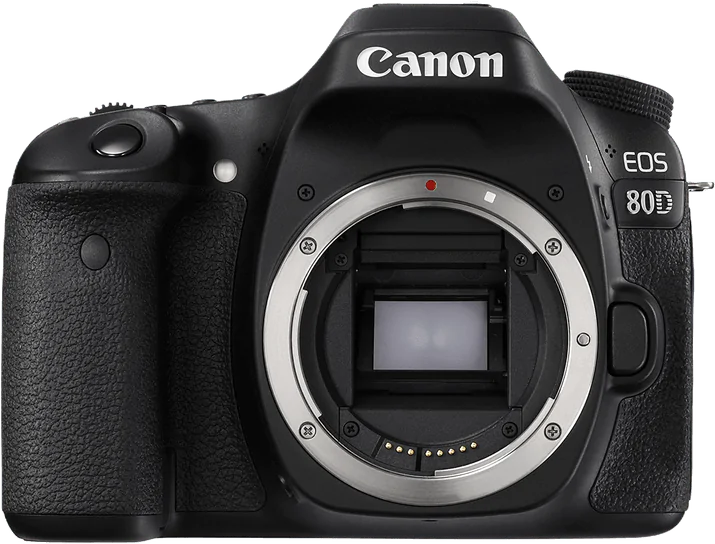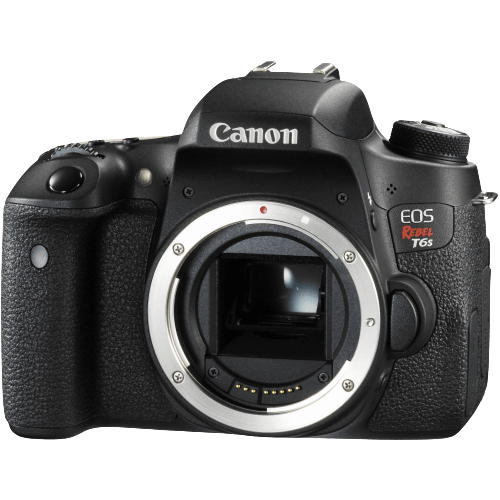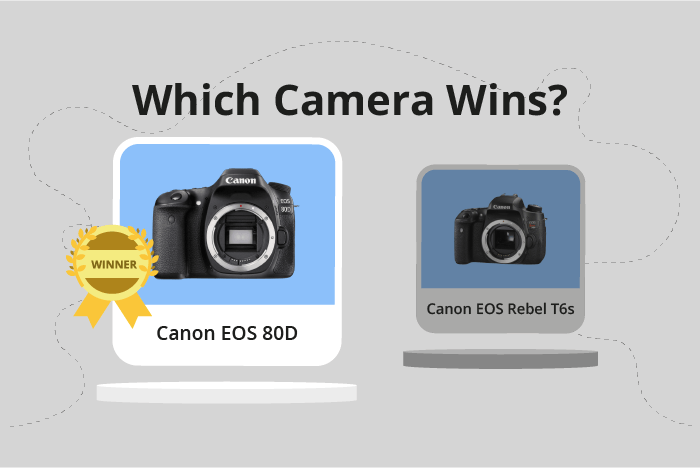Canon EOS 80D vs EOS Rebel T6s / 760D Comparison
Canon EOS 80D

Canon EOS Rebel T6s / 760D

The Canon EOS 80D outperforms the Canon EOS Rebel T6s / 760D with a score of 64/100 to 56/100. Both cameras are DSLR models, announced in 2016 and 2015, respectively. They share similarities in size, with the 80D measuring 139 x 105 x 79mm and the T6s at 132 x 111 x 78mm.
The 80D’s higher score reflects its superior performance. It’s slightly heavier at 730g, compared to the T6s’ 565g, but this extra weight can be attributed to its better build quality. The 80D also offers more advanced features and better overall performance.
On the other hand, the T6s has a lower launch price of $850, making it more budget-friendly than the 80D’s $1200 price tag. This lower cost makes the T6s a more attractive option for those on a tight budget.
Taking these factors into account, the Canon EOS 80D is the better camera for those seeking advanced features and performance, while the Canon EOS Rebel T6s / 760D is a suitable choice for budget-conscious buyers.
Canon EOS 80D vs EOS Rebel T6s / 760D Overview and Optics
The Canon EOS 80D emerges as the winner in the optics comparison with a score of 63/100, a 4-point lead over the Canon EOS Rebel T6s / 760D, which scored 59/100. Both cameras share several key specifications, including a 24.2-megapixel CMOS sensor, Digic 6 processor, APS-C sensor size, Canon EF-S lens mount, and no image stabilization.
The EOS 80D outperforms the Rebel T6s in its shooting speed and DXOMARK score for the sensor. With a shooting speed of 7 frames per second (fps), the EOS 80D is faster than the Rebel T6s, which offers a shooting speed of 5 fps. This difference allows the EOS 80D to capture fast-moving subjects more effectively. Additionally, the EOS 80D has a DXOMARK score of 79 for its sensor, which is 9 points higher than the Rebel T6s’ score of 70. This indicates that the EOS 80D has better overall image quality.
On the other hand, the Rebel T6s has no significant advantages over the EOS 80D in terms of optics. Both cameras share the same sensor type, processor, sensor size, lens mount, and lack of image stabilization. Consequently, the Rebel T6s does not offer any unique optical features that would make it a better choice than the EOS 80D.
Taking these factors into account, the Canon EOS 80D is the superior camera in terms of optics, thanks to its faster shooting speed and higher DXOMARK sensor score. The Rebel T6s, despite sharing several common specifications with the EOS 80D, does not offer any distinct advantages in this aspect. Therefore, the EOS 80D is the better choice for those seeking enhanced optical performance.
Canon EOS 80D vs EOS Rebel T6s / 760D Video Performance
The Canon EOS 80D outperforms the Canon EOS Rebel T6s / 760D in video capabilities, with a video score of 70/100 compared to the T6s / 760D’s 43/100. Both cameras share some common specifications, such as having a Full HD max video resolution and max video dimensions of 1920 x 1080. However, the 80D offers superior features that contribute to its higher score.
A significant advantage of the 80D is its max video frame rate of 60fps, which is double the T6s / 760D’s 30fps. This higher frame rate allows for smoother video footage and better slow-motion effects, making the 80D more suitable for capturing fast-moving subjects or creating cinematic video content. Additionally, the 80D has built-in time-lapse functionality, which the T6s / 760D lacks. This feature enables users to create stunning time-lapse videos without the need for additional equipment or software.
The T6s / 760D does not have any notable advantages over the 80D in terms of video capabilities. Its lower video score reflects its fewer features and reduced performance in this area.
Given the differences in video capabilities, the Canon EOS 80D is the better choice for those who prioritize video performance. Its higher frame rate, built-in time-lapse functionality, and overall better video score make it a more versatile and capable camera for capturing high-quality video content. On the other hand, the Canon EOS Rebel T6s / 760D may still be suitable for casual video users who do not require advanced video features or the highest frame rates but should be considered a less optimal choice for those focused on video performance.
Canon EOS 80D vs EOS Rebel T6s / 760D Features and Benefits
The Canon EOS 80D outperforms the Canon EOS Rebel T6s / 760D with a feature score of 70/100, while the T6s scores 57/100. Both cameras share several specifications, including a 3-inch screen size, 1,040,000-dot screen resolution, touchscreen capabilities, flip screen, GPS absence, Wi-Fi, and lack of Bluetooth.
The EOS 80D’s superiority stems from its higher feature score, which results from a better overall performance. This camera offers enhanced functionality and versatility, making it an ideal choice for those who require a more advanced device. Its features cater to various shooting situations and provide the user with greater control and flexibility, allowing for more creative and professional results.
The EOS Rebel T6s / 760D, however, does not surpass the EOS 80D in any specific aspect. Its lower feature score signifies a less advanced camera compared to its counterpart. Nonetheless, the T6s remains a solid option for beginners or those looking for a more budget-friendly alternative. Its shared specifications with the 80D ensure that it still delivers quality results, despite its lower score.
Taking these points into consideration, the Canon EOS 80D is the superior camera of the two, offering better features and overall performance. This makes it the preferred choice for users seeking a more advanced device. On the other hand, the Canon EOS Rebel T6s / 760D is a suitable option for those with a tighter budget or less demand for advanced features, while still providing quality results.
Canon EOS 80D vs EOS Rebel T6s / 760D Storage and Battery
The Canon EOS 80D outperforms the Canon EOS Rebel T6s / 760D in storage and battery with a score of 43/100 compared to the latter’s 24/100. Both cameras share similarities in their storage, having one memory card slot each and accepting SD, SDHC, and SDXC (UHS-I compatible) memory cards. Neither camera offers USB charging capabilities.
Where the EOS 80D excels is its battery life, offering 960 shots per charge with its LP-E6N battery type. On the other hand, the Rebel T6s / 760D has a shorter battery life, providing only 440 shots per charge using its LP-E17 battery type.
While the EOS 80D has a clear advantage in battery life, the Rebel T6s / 760D does not offer any benefits over its counterpart in terms of storage and battery. Therefore, the Canon EOS 80D stands as the superior choice for those prioritizing storage capacity and battery performance.
Alternatives to the Canon EOS 80D and EOS Rebel T6s / 760D
Are you still undecided about which camera is right for you? Have a look at these popular comparisons that feature the Canon EOS 80D or the Canon EOS Rebel T6s / 760D:

